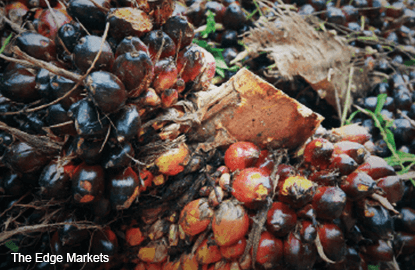
KUALA LUMPUR (Dec 7): Malaysian November palm stocks likely topped a previously reached near 15-year high on slowing exports, despite output falling in line with year-end seasonal trend, a Reuters poll showed.
High stockpiles and low demand could put more pressure on benchmark palm oil prices, which has largely been trading between 2,280-2,340 ringgit per tonne since October.
February palm futures on the Bursa Malaysia Derivatives Exchange reached a four week high of 2,380 ringgit ($563.45) before closing at 2,366 ringgit on Friday.
Inventories in the world's second largest producer remained high on a carry-over from the month before and weaker export demand, leading November's end-stocks to slightly rise 0.1 percent to 2.84 million tonnes from October, according to a median estimate from a survey of 10 planters, traders and refiners.
The rise in inventories would indicate November's end-stocks as the highest since 2000, when Reuters started tracking the data. <MYPOMS-TPO>
The poll estimated a 9.2 percent fall in exports on weaker demand from India as demand normalises after Diwali, the Hindu festive celebration which involves communal feasting and increases the usage of palm oil for cooking.
Data from cargo surveyors Intertek Testing Services and Societe Generale de Surveillance showed a 10 percent fall in November exports compared with the month before.
Malaysian palm oil exports also likely fell as cheaper soybean oil becomes more favourable, according to plantations analyst Ivy Ng at CIMB Research.
"We estimate Malaysian palm oil exports fell... Due to weaker demand from India and U.S.," she said. "This could be due to increasing competition from soybean oil from South America following the narrowing of the price spread between crude palm oil (CPO) and soy oil."
November's expected fall in production by nearly 12 percent was not enough to dent stock levels, as output from the East Malaysian state of Sabah rose.
"Many would guess that production will drop by over 20 percent, that is true as far as Peninsular Malaysia is concerned but Sabah's production went up 17-18 percent," said Lingam Supramaniam, director at Malaysia-based commodities firm Pelindung Bestari.
"The biggest producing state is Sabah, so whatever drop we have in Peninsular Malaysia, Sabah will make up for it."
Malaysia and rival producer Indonesia, which together produce 85 percent of the world's palm oil, have been trying to curb rising palm stockpiles as global consumer demand for the vegetable oil slows.
The Southeast Asian nations formed a joint palm oil council in November to manage high inventories and stabilise palm prices.
The median figures from the survey imply domestic consumption of 291,175 tonnes in November. Breakdown of November estimates (in tonnes):